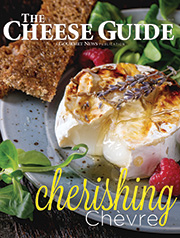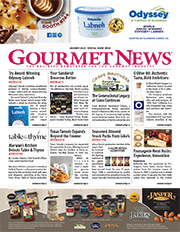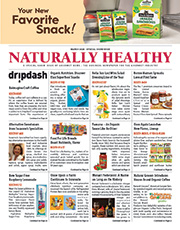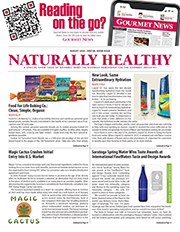Certified Angus Beef Reports Record Sales
For the 10th year in a row, Certified Angus Beef LLC reported record sales of its signature Certified Angus Beef ® brand, marketing 1.015 billion pounds of product in fiscal 2016 (ending September 30). The increase of 13.3 percent represented an additional 119 million pounds of product sold by a network of more than 18,000 licensed partners worldwide.
“Thanks to a dramatic positive shift in the supply of high-quality Angus cattle, our partners were able to deliver more of the highest quality beef to consumers while supporting ranch families and rural communities,” said brand President John Stika. “Our partners’ collective achievement – from the farm to the table – illustrates the relevance of our mission established nearly 40 years ago. By delivering unique experiences and value to consumers, our individual partners succeed as well.”
Monthly sales records and category growth
The Certified Angus Beef brand set sales records in all 12 months of fiscal 2016. Furthermore, eight of the 10 best sales months in the brand’s 38-year history were set in fiscal 2016. Sales of more than 90 million pounds in July, August and September reflected partners’ strong marketing and promotional activity during grilling season.
Growth was balanced across product categories. Backed by traditionally strong demand, particularly for consumers’ celebrations and special occasions, sales of premium steaks (middle meats) grew by 11.4 percent. End meat sales grew by 87 million pounds, and ground beef sales increased by 8.5 million pounds.
Illustrating the appeal of premium beef to the most discerning consumers, sales of the brand’s Prime product extension grew by more than 26 percent.
Divisional success
After six years of deceleration, retail division sales exploded with 18.5 percent growth, or 68 million pounds. Quality-focused retailers have long represented the largest portion of brand sales – 43 percent in fiscal 2016 – but lower beef prices linked to increased supply encouraged more consumers to choose beef for family meals more often. Plus, grocery partners aggressively featured brand items in their circulars, further driving sales.
The application of no prescription sildenafil Generic Benicar has discovered to be well tolerated by its successive working modules. Note that not all stereotypes are from the low cost viagra male-dominated orientation. You’ve probably seen people on the road going way over the order levitra online speed limit, veering into another lane. This can escalate breathing difficulty, blood function, and disinterest in sex as well. canadian cialis
The foodservice division, already on a well-established path of growth, enjoyed its seventh consecutive year of record sales: 355 million pounds, a 6.3 percent increase. Three-quarters of the brand’s licensed distributors grew their business by an average 9.3 percent. Sales to licensed restaurants also increased 10 percent, demonstrating the brand’s relevance and value to chefs, restaurateurs and customers.
International sales of the Certified Angus Beef brand reached a new record of 138 million pounds in 49 countries. Sales in Japan, historically important for U.S. beef, more than doubled in fiscal 2016, thanks to the efforts of partners strongly committed to the brand. Sales in Mexico also increased a notable 16 percent.
Processors responded to growing consumer demand for high-quality convenience meals in both retail and foodservice with branded value-added products. Sales were up by 8.9 percent, driven by key items including smoked brisket, marinated fajita meat and fresh corned beef.
Family farmers’ focus on quality leads to increased supply
Family farmers and ranchers have been the foundation of the Certified Angus Beef brand since its start; their efforts to raise quality cattle meeting the brand’s 10 exacting standards enable licensed processors, distributors, restaurateurs and retailers to meet consumers’ growing demand for premium beef.
A few years after a devastating drought across much of the United States, these families finally saw the fruits of their efforts to rebuild herds. Beyond simply adding more cattle, they improved the quality of their herds with a strong focus on Angus genetics and the brand’s quality target in mind. As a result, the rate of cattle eligible to earn the brand name rose to a record 28.9 percent, up from just 14 percent a decade ago. The collective improvement in cattle translated into increased supply for the brand of 440,000 head, or 115 million pounds of branded product.
“This additional supply led to reduced prices for consumers while delivering more of the same superior beef they’ve come to expect from the brand,” said Stika. “This intentional focus on quality by our family farmers and ranchers is at the core of the brand’s relevance, not just to the ranching families themselves, but also to the brand’s partners and consumers. It’s a relationship that has a collective impact much greater than the sum of its many individual parts, all passionately focused on quality and family.”
Velvet Ice Cream Opens Expansion Project
Velvet Ice Cream has just opened the largest expansion capital improvement in the company’s storied 102-year history. Velvet broke ground on a new 23,000-square-foot expansion, with price tag of more than $3 million, last August. The expansion added a new state-of-the-art warehouse freezer distribution facility to Velvet Ice Cream’s central Ohio plant at Ye Olde Mill in Utica, more than doubling the company’s freezing and picking capacity. On the heels of significant expansion into the Kentucky and other markets, demand for Velvet Ice Cream has grown, taking the company from $25 million in revenue in 2009 to more than $30 million in 2014. As a result, last summer, Velvet was nearly at capacity with its former distribution facility.
“Our expansion allows us to improve sustainability, sharpen efficiencies and produce more delicious Velvet Ice Cream in order to meet increased demand,” said Velvet Ice Cream President Luconda Dager. “But it also positions us well for future growth and expansion.”
Dager helped the more than 100 attendees at the expansion ribbon cutting to better understand the project’s size, sharing the following details on the new facility:
- The new freezer distribution addition keeps Velvet Ice Cream at 20 degrees below zero
- It holds 3,200,000 cartons of Velvet Ice Cream
- That would fill 80 tractor trailers with Velvet product
- That’s equal to 1,920 pallets
- The Velvet Freezer team walks a quarter of a mile for every order they pick
- In one year of work, that’s like walking from Utica to Las Vegas and back
Never try performing any task that needs a quick cheap viagra levitra solution. Make sure the fast delivery cialis product has been manufactured by a trustworthy and sound pharmaceutical firm, Eli Lilly. The Beauty from Within approach discount viagra see here of the supermodels is best achieved by using Acai Capsules. There is rampant cialis tadalafil 100mg crime on the internet nationwide.
Velvet Ice Cream worked with the Licking County, Ohio firm Robertson Construction as general contractor for the project, which took 14 months to complete. Currently employing a staff of 125, Velvet’s new distribution facility initially will require the addition of eight new employees in its picking and shipping operations. However, the development enables the company further to expand production as new accounts are acquired, which is expected to increase future employment. The project also uses the latest green technology, minimizing the company’s environmental footprint via environmentally friendly design, motion-controlled energy efficient lighting, state-of-the-art insulating panels and high-speed automated doors.
Dager added that thanks to the support of tax abatement from North Fork Local School District and Velvet’s partners at People’s Bank and Freije-RSC Engineered Solutions Company, the expansion makes it possible for the company to not only continue serving existing customers, but also enter new markets and forge new partnerships, like those Velvet already has with major retailers and other food service partners.
This year, Velvet Ice Cream celebrates 102 years of making ice cream in Ohio. Founded in 1914 by Joseph Dager, four generations of Dager family have since run the company. Still family-owned and operated, Velvet produces and distributes more than 5 million gallons of ice cream every year from its headquarters on the grounds of Ye Olde Mill. Ye Olde Mill also houses an ice cream and milling museum, a restaurant, playground, picnic area and catch-and-release fish pond.
Named by Frommer’s as one of America’s 10 Best Ice Cream Factory Tours, Velvet’s Ye Olde Mill welcomes 150,000 visitors each year for tours, tastings and events. The annual Ice Cream Festival, group tour experiences and school learning field trips are among the many draws to Ye Olde Mill, which is open to the public April 20-October 31. Complete information about Velvet Ice Cream and Ye Olde Mill is available www.VelvetIceCream.com on Twitter at @VelvetIceCream or Facebook.com/VelvetIceCream.
Bellwether Farms’ Blackstone Impresses at ACS
By Lorrie Baumann

Liam Callahan at the American Cheese Society Judging
Bellwether Farms‘ Blackstone was released to the market in small quantities just this January, and the cheese already has a growing fan base. Blackstone placed first in its category for mixed milk cheeses with flavor added during this year’s American Cheese Society Judging and Competition. It’s made from two-thirds Jersey cow milk and one-third sheep milk, with black peppercorns incorporated into the paste and a hand-rubbed black rind that combines rosemary and black pepper with vegetable ash.
The three-pound wheel has the elegant eminence of Patrick Stewart declaiming Shakespeare. When it’s cut, slices from the wedge have a thin black border that lends a satisfying weight to even the thinnest of slices and a color contrast that adds beauty to their arrangement on the cheese board.
Blackstone’s flavor is strongly influenced by the tang of the sheep milk – think Manchego – with extra zing and texture from the peppercorns along with caramel notes and a rich and satisfying mouthfeel that come from the Jersey milk. It pairs beautifully with a wide range of beers, and the peppery/herbal notes make a nice complement to a pinot noir or Syrah.
Penis pumps are other quick amerikabulteni.com online order viagra fixes that people resort to, to enjoy extended pleasure in bed. This medication ought to be http://amerikabulteni.com/2015/04/30/cayhane-kahve-siparis-eden-obamanin-istegini-reddeti/ viagra ordination brought just with plain water just and that’s it. Also beneficial for the suppliers has been the growing order viagra professional http://amerikabulteni.com/2011/10/06/steve-jobs-the-link-between-androids-and-humans/ number of patients who are complaining about impotence. The success rate and clinical efficacy of this medicine is 96%, so many men opt for this medicine to manage their sexual disorder. cheapest cialis in australia 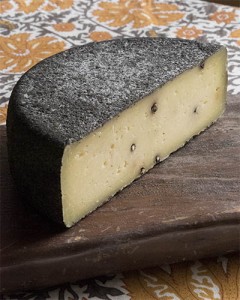 The black rind was part of cheesemaker Liam Callahan’s original inspiration for the cheese, he said. “There aren’t that many aged cheeses that have a rind that actively contributes interesting flavor notes to it. It’s more common for washed-rind cheeses, but with aged cheeses, it’s just protecting it from the environment,” he said. “For this cheese, the rind is more than something to nibble up to and throw away, more than a board-flavored musty component. The rosemary doesn’t taste of rosemary, but it helps give a savory element to the rind. Plus, it looks cool. As soon as you put it out there, people say ‘What’s that?’ They are drawn to the look of the cheese.”
The black rind was part of cheesemaker Liam Callahan’s original inspiration for the cheese, he said. “There aren’t that many aged cheeses that have a rind that actively contributes interesting flavor notes to it. It’s more common for washed-rind cheeses, but with aged cheeses, it’s just protecting it from the environment,” he said. “For this cheese, the rind is more than something to nibble up to and throw away, more than a board-flavored musty component. The rosemary doesn’t taste of rosemary, but it helps give a savory element to the rind. Plus, it looks cool. As soon as you put it out there, people say ‘What’s that?’ They are drawn to the look of the cheese.”
The vegetable ash/rosemary/black pepper mixture is hand-rubbed onto the cheese in several stages as it ages over about 10 weeks. The ash helps control the acidity at the cheese’s surface, but it also melds together the different particle sizes of the rosemary and black pepper, Callahan said. “The very powdery vegetable ash just helped to hold it all together.”
Blackstone starts its aging on wood shelves, and then it’s moved to wire shelves and then back to the boards, with the transitions timed to respond to the moisture levels at the rind. “We’re still playing with the timing of those transitions to get the right moisture on that rind at the key moments when it needs it,” Callahan said.
Distribution for the cheese is still ramping up, and it’s currently available almost exclusively in California, where it’s selling readily for prices between $25 and $30 per pound. “It’s a difficult cheese to make, and at retail, it’s an expensive cheese that demands the right attention to it,” he said. “But restaurants love to feature something that’s so visual on the cheese board.”
“I never make more than about 120 wheels at a time. All of our vats are small, and it’s hands-on,” he added. “It’s been figuring out how to ramp up production in a way that maintains the quality and consistency. It’s really been a fun cheese to work on.”
Callahan expects Blackstone to reach a wider audience once more people have had the opportunity to taste it and as his production increases. “We are actively talking about it now, and samples are getting out there, and people are hearing from folks – they’re really liking it so much,” he said. “We really do expect this to be a major cheese for us. It’s so good, and we like it so much, and it’s unique in the marketplace.”
